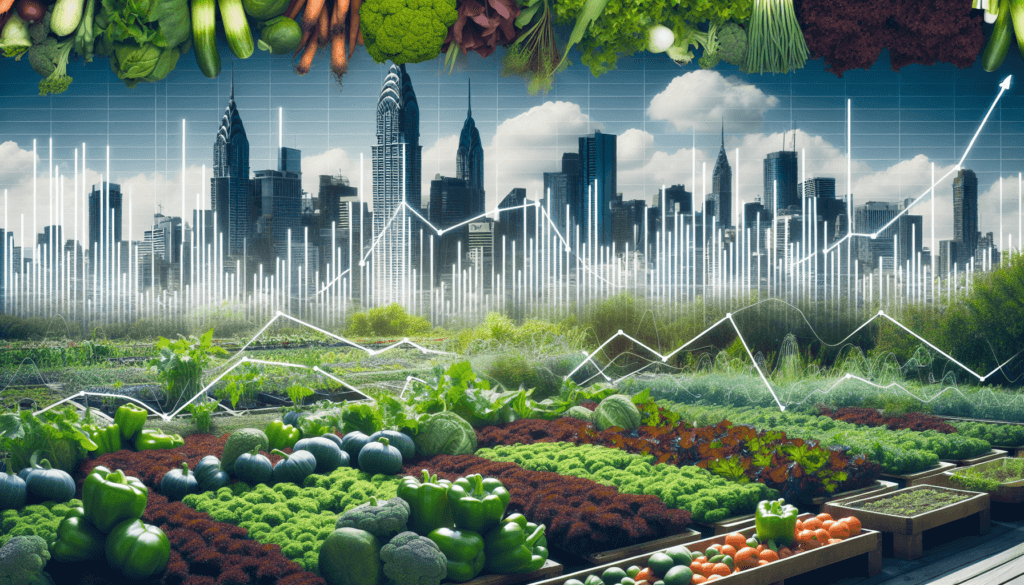Imagine a world where abandoned plots of concrete and asphalt are transformed into vibrant green spaces bursting with life. Where the hustle and bustle of urban life is complemented by the soothing presence of flourishing gardens. In this article, we will explore the fascinating and often underestimated impact of urban gardening on local economies. From job creation to improved property values, discover how the simple act of planting seeds can nurture not only the environment but also the economic well-being of communities. So, grab your gardening gloves and join us on this journey of growth and prosperity.

I. Economic Benefits of Urban Gardening
A. Job Creation
Urban gardening not only provides individuals with the opportunity to grow their own food, but it also creates employment opportunities within the community. From garden maintenance and landscaping to urban farming and farmers’ market management, urban gardening generates a range of jobs. These diverse employment options can contribute to reducing unemployment rates and boosting the local economy.
B. Increased Tax Revenue
The economic benefits of urban gardening extend beyond job creation. By stimulating economic activity, urban gardening generates increased tax revenue for local governments. As more individuals engage in gardening activities, the purchase of gardening supplies, equipment, and plants contributes to sales tax revenue. Furthermore, the sale of locally grown produce at farmers’ markets generates additional tax revenue. This increased tax revenue can be used to fund public services and infrastructure improvements that benefit the entire community.
C. Decreased Food Costs
Urban gardening offers the potential for significant cost savings for individuals and families. By growing their own fruits, vegetables, and herbs, individuals can reduce their reliance on expensive store-bought produce, effectively decreasing their monthly food costs. This allows households to allocate their financial resources to other essential needs, such as education, healthcare, and housing, thereby improving overall financial stability within the community.
D. Boosted Local Businesses
Urban gardening can provide a boost to local businesses, generating a ripple effect throughout the community’s economic ecosystem. As more individuals engage in gardening activities, there is an increased demand for gardening supplies, tools, and equipment. This creates an opportunity for local garden centers and hardware stores to thrive, benefiting from the increased customer base. Additionally, the sale of produce at farmers’ markets and local grocers supports local businesses, contributing to the vitality of the community’s economy.
II. Environmental Advantages of Urban Gardening
A. Reduced Carbon Footprint
Urban gardening plays a crucial role in reducing carbon emissions and mitigating climate change. By growing food within urban areas, the need for long-distance transportation of produce is significantly reduced. This results in decreased carbon emissions associated with transporting food from rural agricultural regions to urban centers. Additionally, urban gardens act as carbon sinks, absorbing and sequestering carbon dioxide from the atmosphere, further contributing to environmental sustainability.
B. Improved Air Quality
The presence of urban gardens helps improve air quality by reducing pollution levels in urban areas. Plants absorb carbon dioxide and release oxygen, increasing the oxygen content in the surrounding air. Moreover, urban gardens help filter harmful pollutants, such as nitrogen dioxide and particulate matter, thereby reducing respiratory health issues. The overall improvement in air quality in urban spaces creates a healthier environment for residents and contributes to a better quality of life.
C. Enhanced Biodiversity
Urban gardens serve as essential green spaces that support biodiversity within urban environments. By providing habitats for various species of plants and animals, urban gardens contribute to the preservation of local ecosystems. Bees, butterflies, and other pollinators are attracted to the flowers and plants, promoting pollination and ensuring the growth of other plants in the area. This enhanced biodiversity fosters a more balanced and sustainable ecosystem within urban spaces.
D. Minimized Food Waste
Urban gardening plays a vital role in reducing food waste, which is a significant environmental concern. By growing their own produce, individuals can control the quantities they harvest, reducing the likelihood of excess food being wasted. Additionally, initiatives such as community gardens often incorporate composting systems, allowing food scraps to be recycled into nutrient-rich soil. This reduces the amount of organic waste that ends up in landfills, minimizing greenhouse gas emissions and promoting a more sustainable food system.
III. Social Benefits of Urban Gardening
A. Community Building
Urban gardening serves as a catalyst for community building, bringing individuals together to work towards a common goal. Community gardens provide a space for people to connect, share knowledge, and develop relationships with their neighbors. Collaborative gardening activities foster a sense of ownership and pride within the community, strengthening social bonds and creating a supportive network. This sense of community can extend beyond the garden walls, positively influencing the overall well-being and social fabric of the neighborhood.
B. Healthier Lifestyles
Engaging in urban gardening encourages healthier lifestyles, benefiting individuals’ physical and mental well-being. Gardening requires physical activity, providing an opportunity for exercise and promoting physical fitness. Additionally, the consumption of fresh, homegrown produce contributes to a healthier diet, rich in nutrients and free from harmful chemicals. The act of gardening itself has also been shown to have positive effects on mental health, reducing stress levels and promoting a sense of well-being.
C. Education and Skill Development
Urban gardening presents valuable opportunities for education and skill development, particularly among younger generations. Schools and community organizations can incorporate gardening into their curriculum and programs, providing hands-on learning experiences. Gardening teaches important skills such as problem-solving, teamwork, and responsibility. Furthermore, gardening can promote environmental awareness and sustainable practices, enabling individuals to make informed choices that positively impact the environment.
D. Access to Fresh Produce
Urban gardening addresses the issue of food deserts, which are areas with limited or no access to fresh, affordable produce. By cultivating fruits and vegetables within urban spaces, individuals have direct access to fresh, nutrient-rich produce. This enhances food security and improves overall nutrition within the community. Furthermore, urban gardens often engage in initiatives such as gleaning programs or food donations, ensuring that surplus produce reaches those in need, thus reducing food insecurity.
IV. Case Studies Demonstrating Economic Impact
A. Detroit, Michigan
Detroit, once a struggling city, has experienced a revitalization driven in part by urban gardening initiatives. From neighborhood gardens to large-scale urban farms, Detroit’s urban gardening movement has created jobs, increased tax revenue, and boosted the local economy. Vacant lots have been transformed into productive green spaces, attracting both residents and visitors to experience the city’s transformation. Additionally, Detroit’s urban gardens have improved food access for residents, addressing issues of food insecurity and benefiting public health.
B. Portland, Oregon
Portland has long been recognized as a leader in urban gardening and sustainable living. The city’s commitment to urban agriculture has yielded significant economic benefits. Urban gardening has provided job opportunities in various sectors, including sustainable farming, resource management, and food processing. Portland’s vibrant farmers’ markets and farm-to-table restaurant scene have boosted local businesses and increased tourism, highlighting the economic potential of urban gardening.
C. Chicago, Illinois
Chicago has embraced urban gardening as a means of economic revitalization and community development. The city has implemented various programs and policies to support urban agriculture, including the creation of rooftop gardens and community plots. Urban gardening initiatives have not only created employment opportunities but also encouraged entrepreneurship and small business growth. Chicago’s urban farming movement has transformed underutilized spaces into thriving green oases, positively impacting both the economy and the environment.
D. Vancouver, Canada
Vancouver has integrated urban gardening into its urban planning strategies, focusing on community engagement and sustainability. The city has allocated public spaces for urban farming, providing residents with accessible areas to grow their own food. Vancouver’s urban gardens have sparked social innovation, fostered community connections, and supported local businesses. Moreover, the city’s urban farming initiatives have reduced greenhouse gas emissions and improved food security, demonstrating the multifaceted benefits of urban gardening.

V. Government Support and Policies
A. Grants and Funding
Government agencies and organizations often provide grants and funding opportunities to support urban gardening projects. These financial resources help cover start-up costs, infrastructure development, and educational programs. Grants can be obtained from various sources, including local governments, nonprofit organizations, and federal agencies, ensuring that urban gardening initiatives have the necessary financial support to thrive.
B. Public-Private Partnerships
Collaborations between government entities and private organizations can leverage resources and expertise to support urban gardening. Public-private partnerships can facilitate the development of community gardens, provide technical assistance, and create marketing campaigns to promote urban agriculture. By combining the strengths of both sectors, these partnerships maximize the economic and social benefits of urban gardening.
C. Zoning and Land Use Regulations
Governments can play a role in supporting urban gardening by implementing favorable zoning and land use regulations. This can include designating land specifically for community gardens or incorporating urban farming into existing zoning codes. By providing clear guidelines and removing unnecessary barriers, local governments can encourage the expansion of urban gardening and facilitate its integration into urban landscapes.
D. Tax Incentives
Government tax incentives can further incentivize urban gardening and stimulate economic growth. Tax breaks or reductions on property taxes for individuals or businesses involved in urban gardening can encourage investment in green infrastructure and support local growers. These incentives not only benefit the individuals and businesses directly involved in urban gardening but also contribute to the overall economic development of the community.
VI. Challenges and Limitations of Urban Gardening
A. Limited Space
One of the primary challenges of urban gardening is limited space. Urban areas often have limited land available for gardening, making it difficult to accommodate large-scale operations or meet the demand for community gardens. However, innovative gardening techniques such as vertical gardens, rooftop gardens, and indoor hydroponics can help overcome space limitations and maximize productivity in urban environments.
B. Soil Contamination
Contamination of urban soil poses a significant challenge to urban gardening. Historically industrialized areas may have soil contaminated with heavy metals or pollutants, making it unsafe for growing edible plants. Soil testing and remediation initiatives are essential to identify and address contamination issues, ensuring the safety of urban gardeners and the quality of the produce they grow.
C. High Start-up Costs
Urban gardening often requires substantial initial investment in infrastructure, equipment, and supplies. These costs can be a barrier for individuals or communities looking to embark on gardening initiatives. However, government grants, community fundraising, and partnerships with local businesses can help alleviate these financial burdens, making urban gardening more accessible and sustainable.
D. Lack of Expertise
Another limitation of urban gardening is the lack of expertise among aspiring gardeners. Many individuals may not possess the necessary knowledge or skills to successfully grow plants in an urban environment. Providing education and training programs can help bridge this knowledge gap, empowering individuals to become confident urban gardeners. Community organizations, schools, and government agencies can play a pivotal role in providing resources and expertise to support the development of gardening skills within urban communities.

VII. Successful Models of Urban Gardening
A. Rooftop Gardens
Rooftop gardens utilize the untapped potential of urban rooftops to create green spaces and cultivate produce. These gardens often employ lightweight soil, raised beds, and container gardening to maximize productivity while minimizing structural load. Rooftop gardens not only provide fresh food but also contribute to energy efficiency by reducing heat absorption and improving insulation. They serve as models of sustainable urban gardening that utilize underutilized spaces to their full potential.
B. Vertical Gardens
Vertical gardens, also known as living walls or green walls, utilize vertical space to grow plants vertically, making efficient use of limited space. These gardens can be installed on the exterior or interior walls of buildings, transforming barren walls into lush greenery. Vertical gardens often utilize hydroponics or aeroponics systems, allowing plants to grow without soil. These innovative gardens are not only visually appealing but also contribute to improved air quality and increased biodiversity within urban areas.
C. Community Gardens
Community gardens bring individuals together to collectively utilize a shared space for gardening activities. These gardens can be managed by local organizations, schools, or neighborhood associations. Community gardens promote education, collaboration, and social cohesion within the community. They provide opportunities for individuals without access to land or resources to engage in gardening, fostering a sense of community ownership and benefiting individuals from diverse backgrounds.
D. Indoor Hydroponics
Indoor hydroponics is a growing trend in urban gardening that allows plants to thrive without traditional soil. Hydroponic systems use nutrient-enriched water solutions to deliver essential nutrients directly to the plants’ roots. These systems can be set up indoors, utilizing unused space such as basements or spare rooms. Indoor hydroponics allows for year-round cultivation, circumventing the limitations of seasonal gardening and increasing food production in urban areas.
VIII. Economic Multiplier Effects of Urban Gardening
A. Increased Property Values
The presence of urban gardens has been shown to increase adjacent property values. Green spaces and gardens contribute to the aesthetic appeal of neighborhoods and attract potential buyers or renters. Thus, urban gardening can have a positive ripple effect on property values, enhancing the economic well-being of homeowners and real estate investors.
B. Economic Diversification
Urban gardening fosters economic diversification by creating opportunities in new and unique sectors. This includes areas such as sustainable agriculture, organic food production, and urban farming equipment manufacturing. By diversifying the local economy, urban gardening reduces dependence on traditional industries and promotes economic resilience.
C. Tourism and Cultural Appeal
Vibrant urban gardens and farmers’ markets attract tourists and visitors, contributing to the local economy through increased tourism revenues. Urban gardening initiatives often showcase the cultural heritage and diversity of a community, adding to the appeal of the destination. By incorporating urban gardens into tourism strategies, cities can leverage their unique cultural offerings and create a sustainable tourism environment.
D. Enhanced Food Security
Urban gardening improves food security within a community by reducing reliance on external food sources and increasing local food production. This ensures a stable supply of fresh produce, even in times of disruption or crisis. By enhancing food security, urban gardening contributes to the economic stability and resilience of a community.

IX. Future Prospects and Opportunities
A. Urban Farming Technologies
Advancements in technology, such as vertical farming systems, hydroponics, and aquaponics, present exciting prospects for urban gardening. These technologies allow for increased productivity and resource efficiency, paving the way for urban agriculture to thrive even in limited spaces. As urban farming technologies continue to evolve, the economic and environmental impact of urban gardening is expected to grow significantly.
B. Integration with Local Businesses
The integration of urban gardening with local businesses can create symbiotic relationships that benefit both parties. Restaurants and food establishments can source locally grown produce from urban gardens, supporting local growers and promoting sustainability. Likewise, urban gardens can provide an additional revenue stream by selling their produce to local businesses, further stimulating economic growth within the community.
C. Policy Expansion and Support
Governments have a crucial role in expanding and supporting urban gardening through policy development. By implementing supportive policies, such as allocating more public land for community gardens or implementing incentives for urban farming, governments can create an environment conducive to the growth of urban gardening. Continued policy expansion and support will further enhance the economic benefits of urban gardening.
D. Sustainable Urban Development
Urban gardening aligns with the principles of sustainable urban development, promoting environmentally friendly and socially equitable practices. As cities continue to prioritize sustainability in their development plans, urban gardening will become an integral part of urban landscapes. By integrating urban gardening into sustainable development initiatives, cities can create thriving, resilient, and equitable communities.
X. Conclusion
Urban gardening offers a multitude of economic, environmental, and social benefits to local communities. From job creation and increased tax revenue to improved air quality and healthier lifestyles, the impact of urban gardening is far-reaching. Successful case studies, government support, and innovative gardening models are evidence of the potential and opportunities that urban gardening presents. As cities continue to prioritize sustainable development and community well-being, urban gardening will play an increasingly significant role in shaping resilient, vibrant, and economically prosperous urban environments.



